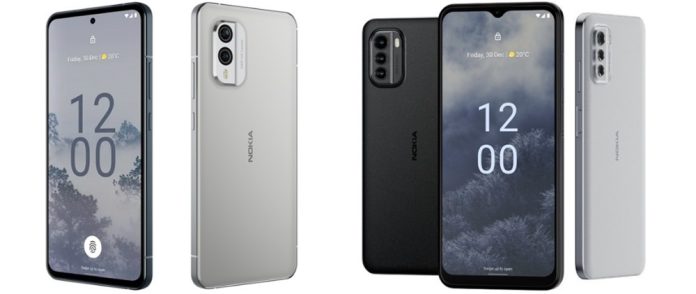In the past, with mobile technology it’s easier to recommend one phone over the other, just based on price. But for the first time in mobile technology, we have a mid-range Nokia G60 5G device that’s more affordable than the Nokia X30 5G but has its own added advantages that make it more attractive to consumers based on their needs.
In this review article, we’ll compare the differences and similarities between Nokia’s eco-friendly X30 5G and the G60 5G.
Let’s start with the aesthetics. With both devices in hand, its quite clear the G60 is a bit taller than the X30 and slightly thicker. While the G60 measures at 165.99 tall x 75.93 wide x 8.61mm thick with a weight 190g, the X30 measures at 158.9mm tall x 73.9mm wide x 7.99mm think, at the friendly weight of 185g, making it the more pocket friendly option.

Taking a closer look at the exterior design of both phones, you notice that the X30 5G has two microphones on the top, while the G60 5G has only one microphone. However, both devices have an additional microphone and speaker at the bottom exterior.
While on appearance both speakers look the same, the speakers on the X30 5G is much louder and clearer in comparison to the G60 5G.
When we look at screen display, both devices are a step in a new direction regarding screen protection, with the Gorilla Glass Victus protecting the Nokia X30 5G while the G60 5G settles for the Gorilla Glass 5. However, the Nokia X30 5G does have an added advantage here with its Gorilla Glass DX+ finish, which is scratch resistant.
In terms of durability, the X30 G5 is equipped with a IP67 water and dust resistant rating, while the G60 5G has an IP52 rating which means the X30 can withstand being fully submerged in water, while the G60 will only be able to withstand splashes.

Regarding performance and compatibility, with just an IPS LCD display, the Nokia G60 5G is certainly impressive when compared to the AMOLED display on the Nokia X30 5G. Although the Nokia X30’s AMOLED display should be better, the G60 G5 has an almost equal visual experience than more premium phones within the same category.
However, the Nokia G60 5G has a faster refresh rate at 120Hz in comparison to the X30 at 90Hz, making the G60 smoother when scrolling and transitioning between apps or playing games.
Another key differentiating feature is the IR blaster. While the X30 5G is equipped with an infrared IR blaster, the G60 5G is not. For those who may not know, IR blasters allow your mobile device to be turned into a universal remote controller, which can be used to communicate with home or office entertainment components such as TVs, air conditioners, audio receivers, DVD players or almost any IR-controlled appliance.
Both the X30 and the G60 devices can handle heavy-duty usage. However, with the plastic finish on the Nokia G60 versus the metallic finish on the Nokia X30, and with plastic being a better heat insulator naturally, means that for prolonged use or heavy usage the Nokia G60 5G is less likely to get warm than the Nokia X30 5G.
In terms of practicality, the Nokia G60 is considered more practical than the X30. unlike the X30 which allows earphone/headphone connectivity only via Bluetooth, the G60 is equipped with a 3.5mm headphone jack.
Thanks to the well optimized software, android 12 runs well with no issue on both devices. In terms of storage, the X30 5G maxes out at 8GB RAM and 256 GB storage while the G60 maxes at 6GB RAM and 128GB storage. However, the Nokia G60 supports a microSD card, which means you can expand on the built-in memory.
Also, both devices are equipped with fingerprint technology, however the power button on the right side of the Nokia G60 5G also houses the fingerprint scanner, while the fingerprint scanner is available on the display screen of the Nokia X30. In terms of speed, they are both identical, but in everyday use, it’s more practical to reach the fingerprint scanner without having to look at the device, making it easier for muscle memory.

For camera, the X30 has a huge advantage when compared with the G60, and the difference may not be obvious if you just look at key figures. In fact, based on optics the G60 has a numerical advantage by featuring four cameras in total versus only three on the Nokia X30, but more doesn’t necessarily mean better.
While both devices feature 50MP sensor, not all 50MP sensors are created equally. The X30 sensor is much bigger and features optical image stabilization. In high light images, color processing of the X30 can is just as good as the G60, however the X30 captures much better resolution details and this difference becomes even bigger when you compare images taken with both devices in low lights.
There’s simply no comparison here as the Nokia X30 thrives better in low light in comparison to the Nokia G60. This includes how much light it can capture as well as the resolved details and sharpness.
Also in video recording, even though both devices are limited to 1080P at 60 frames per second, the larger sensor on the X30 captures better details and with the ultra-wide cameras it’s a similar story. With 13 MP Ultra-wide cameras on the X30 versus a 5MP Ultra-wide on the G60, the X30 has a notably larger sensor, which means that images taken with the X30 are much better in all lighting conditions.

The imaging advantage of the X30 also extends to the front facing camera. On paper or the X30 has a 16 MP sensor versus an eight-megapixel sensor on the G 60, however the X30 uses pixel binning so it produces 4MP images. On the other hand, the G60 produces full resolution 8MP images. But despite the Mega pixel advantage when it comes to resolved details and color processing the X30 does a much better job than the G60.
Regarding battery life, the Nokia G60 comes with 4500 milliamps battery, versus 4200 found on the X 30 and that difference may be because of the X30 being the more compact smart phone. In mixed usage with 5G and Wi-Fi you can get about seven hours on the x30 versus slightly over eight hours on the G 60 so there is a slight advantage for the bigger battery with charging speed on the other hand X30 can reach up to 33Watts versus about 20 Watts on the G60.
Also, the X30 takes about 30% less time to fully charge its battery. However, if the aim is to get a device that lasts as long as possible on a single charge, the better choice between the two devices would be the G60.
In conclusion, if you’re looking at getting a new device that’s practical and affordable, then the G60 is for you. However, if you’re a user interested in premium quality device with great design, quality, and imaging, then the X30 is your best bet.














